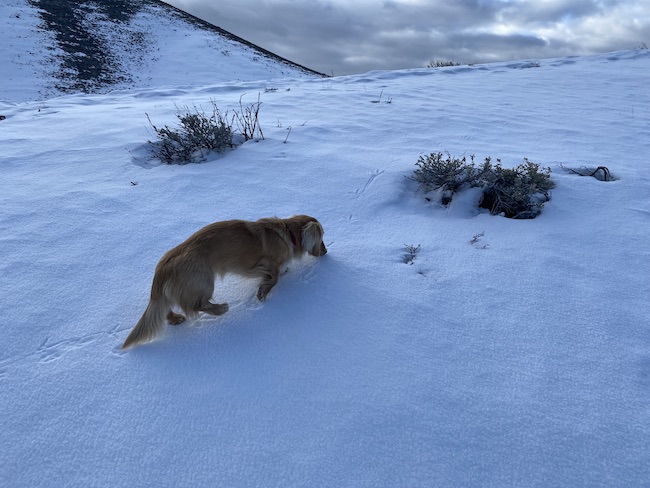BY HARRY WEEKES
In early April, Whiskey, Olive and I started to the backyard. I reached for the snowshoes, then cut myself off. Several tentative steps onto the snow, my hopes coalesced in a thought—“It’s going to hold me.”
Inspired, I told the dogs, “I’m following you.” This is the only time of the year when you can walk anywhere you want as easily and directly as possible, or as indirectly.
Olive took the most understandable and predictable path—she walked out, sniffed the air, turned around, and returned to bed. For his part, Whiskey took off to the left, heard a magpie croaking in the willows to the right, headed off in that direction until he crossed the scent of something, where he took on the appearance of a beachcombing treasure hunter—acting as both the organism and the apparatus.
His nose could not have been a quarter of an inch from the ground as he snuffled back and forth directly to the small ridge, where he started a beeline up. I looked down to see bird tracks. Initially, I thought they were from the magpie. After following them for some distance, it dawned on me—“These are grouse tracks.”
And these tracks created an amazingly straight line directly up the hill. Since it had barely dusted snow starting sometime after midnight, I knew the following: these fresh tracks had to be made between then and 7:30 a.m. This bird walked alone. This bird never stopped to eat or go to the bathroom, and it kept the same gait from the bottom of the hill to the top.
I don’t know when the last time you’ve held birds’ feet, but to imagine they would leave a discernable scent in snow is difficult to imagine. And yet, Whiskey followed them as though they were a bright stripe painted on the ground (and as though he was following by vision, not smell).
Toward the top of the hill, I wondered, “Where is this bird headed?” right about when the footprints ended—replaced by the impression of its wings… and nothing else. I turned slowly around, took in the view, and answered my own question: “Anywhere.” Which I think is the point for a prey species being followed by two potential predators.
As the hard ground held in early April, I learned more: what grouse tracks look like over three days in the sun; that the grouse, or multiple grouse, used this ridge as a stairway of sorts, mostly in the early morning; that, periodically, and seemingly randomly, the bird would nibble on the outstretched limbs of sage; what fresh grouse droppings look like; that at least one of the grouse was a dusky grouse who ducked into the lone Douglas fir standing just off the path; and that a mini-Dachshund looks really, really funny chasing a grouse 20 feet above its head and increasingly farther and farther away.
April can often feel like the Thursday of months; a kind of limbo between things. Wonderfully, the natural world has a penchant for such spaces.
So it is that here, on this tiny ridge, itself but a small fold in the corduroy of hills, there is a grouse who takes uphill morning walks made easier by the crusted snow of spring. There is a point, I like to imagine both a physical spot and a convergence of morning light, where the bird explodes into the air and shoots through one canyon or another. And then, she does it again. Because it’s early April. And the conditions are perfect.
Harry Weekes is the founder and head of school at The Sage School in Hailey. This is his 53rd year in the Wood River Valley, where he lives with Hilary and two mini-Dachshunds. The baby members of their flock have now become adults—Georgia and Simon are fledging in North Carolina, and Penelope is fledging in Vermont.



